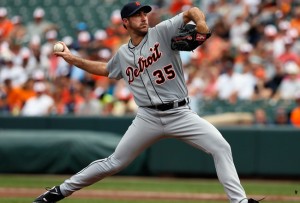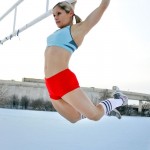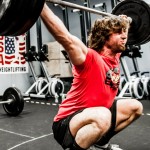Brian Schiff’s Blog
Injury Prevention, Sports Rehab & Performance Training Expert

Photo from Bleacher Report
Shoulder surgery is a big concern for any professional pitcher. I am currently rehabbing two MLB pitchers (one from a labral repair and the other from a Tommy John procedure and obviously not JV pictured above). They are doing great so far in their early rehab, but time will tell if they make it back to their pre-injury pitching levels.
Overuse injuries in youth baseball players is always a huge concern I have. In fact, I speculate that early wear and tear may contribute to injuries seen down the road in HS, college or the pro ranks. I know from coaching and observing that more youth coaches need to familiarize themselves with pitch count guidelines and rest/recovery recommendations that Little League baseball now endorses.
As a sports physical therapist who sees 12 year-olds with RC problems and torn UCLs and as a father/coach of a 10 y/o left-handed pitcher, I have a strong passion and vested interest in the welfare of baseball pitchers. While research does not equate increased injury risk with throwing curveballs and sliders to date per se, both of my MLB clients advise against it until athletes turn 14 or 15.
For information on injury prevention and pitching guidelines for youth, check out this website:
http://www.asmi.org/research.php?page=research§ion=positionStatement
Today’s blog post focuses on outcomes following surgery for elite pitchers. The following information was just published in the Jul/Aug 2013 edition of Sports Health by Harris et al. based on literature review based on these outcome measures:
Primary = pitcher’s rate of return to sport (RTS) at the same level prior to injury
Secondary = rates of RTS regardless of level, performance upon RTS and clinical outcome scores
“Elite” was defined as throwing in at least one game in MLB, minor league (A, AA, or AAA) or all collegiate divisions. Six level I-IV studies were included with enrollment from 1976 – 2007, and there were 287 elite male pitchers who underwent shoulder surgery with 99% on the dominant throwing shoulder. Most pitchers (276) were professional with a mean career length of 6.58 years. Post-operative clinical follow-up within these studies was 3.62 years.
Primary diagnoses treated:
- RC tear = 120 (43%)
- Internal impingement = 82 (30%)
- Labral tear = 74 (27%)
Surgical procedures performed:
- Labral repair (157) or labral debridement (99)
- RC repair (29) or debridement (162)
- Thermal capsulorrhaphy (63)
- Subacromial decompression (42)
The statistics reveal more debridement of the labrum (61%) and rotator cuff (85%) versus repair. This is not necessarily surprising given the desire to minimize surgical intervention and loss of motion.
Return to Sport Data
- The overall rate of return to sport was low at 68%.
- Mean time to return to competitive pitching in a game situation was 12 months (range = 9 -17)
- 22% of MLB pitchers never pitched again in MLB
- Only 14% returned to competitive pitching in the same season as labral surgery
- No one returned to competitive pitching in the same season after rotator cuff surgery
- Reynolds et al reported a median of 2 seasons of pitching after debridement of partial thickness cuff tears
- Mazoue and Andrews reported a mean of 0.7 seasons pitching (range 3 innings to 3 seasons) after mini-open RC repair
Performance declined for the 3 seasons prior to surgery and then gradually increased for 3 seasons afterward, but generally did not reach pre-injury levels.
Search results for: internal impingement
It is no secret that proper scapula alignment and muscle activation makes for a healthy shoulder. There are many forms of dysfunction that may be present.

Generally speaking problems revolve around muscular tightness/weakness and faulty movement patterns. The term “SICK” scapula is often used and refers to Scapula Inferior Coracoid Dyskinesis. Common examples of a “sick” scapula include:
- Type I – Inferior border prominence. This is typically related to tightness in the pec minor and weakness in the lower trapezius. Keep in mind the upper trapezius will naturally dominate the lower trap in the force couple with the serratus anterior for upward rotation. You may also see increased thoracic kyphosis which will inhibit the normal resting position of the scapula.
- Type II – Medial border prominence. In this case the scapula is internally rotated or protracted and there is liekly weakness present in the rhomboids and middle trapezius. The serratus anterior may also likely be weak with evidence of scapular winging. This position places the humerus in relative internal rotation and increases risk of impingement with arm elevation.
- Type III – Superior border presence. Here the scapula appears elevated in the face of an overactive upper trap and/or levator scapulae. With active arm elevation, you may notice excessive shrugging or superior humeral head migration in light of the imbalance. Again, the lower trapezius is probably weak and being overpowered.
Click here for a great graphic display from the Journal of the American Academy of Orthopaedic Surgeons of how the scapular muscles work collectively as a force couple to promote optimal movement in the shoulder.
In many of the throwers and overhead athletes I see in the clinic, they often exhibit either medial border prominence of inferior border prominence. Additionally, I frequently observe GIRD (glenohumeral internal rotation deficit) values of 20 degrees or higher in those patients who come in with symptomatic shoulders (rotator cuff and/or labral issues). What does this mean?
Well, in a nutshell, it means addressing posterior capsule tightness in the throwing shoulder is important for avoiding internal impingement and SLAP tears. Tightness (or too much GIRD) can increase the load/tension in the late cocking phase of throwing thereby contributing to friction between the cuff and labrum, as well as excessive torsion on the proximal biceps tendon. Any excessive humeral head migration with repetitive throwing is a recipe for injury over time.
Search results for: internal impingement
So, I treat a number of fitness enthusiasts in the clinic and many include Crossfit clients. Recently, I evaluated a 38 y/o male on 2/16/12 with a 3 month history of right shoulder pain. He performs Crossfit workouts 6 days per week. His initial intake revealed:
- Constant shoulder pain that worsens with overhead movements
- Pain with bar hangs, overhead squats and wide grip snatches
- Unable to do kipping (only doing strict form pull-ups)
- Pain if laying on his right side at night
- No c/o neck pain, referred pain or numbness/tingling
Notice the shoulder position during the kipping pull-up and overhead squat below. This is a position of heightened risk for the shoulder.
His exam revealed the following:
- Normal range of motion
- Strength within normal limits except for supraspinatus and external rotation graded 3+/5 with pain
- Positive impingement signs
- Negative shrug sign
- Negative Speed’s and O’Brien’s test
- Tender along distal supraspinatus tendon
Based on the clinical exam, it was apparent he had rotator cuff inflammation and perhaps even a tear. Keep in mind he had not seen a physician yet. I began treatment focused on scapular stabilization and rotator cuff strengthening as well as pec and posterior capsule stretching to address the impingement. Ultrasound and cryotherapy were used initially to reduce pain and inflammation.
One month following the eval
By 3/14/12, his pain was resolved with daily activity and he had returned to snatches and push-press exercises without pain. He still could not do overhead squats with the Olympic bar pain free, but he could with a pvc pipe. Strength was now 4/5 for supraspinatus and 4+/5 for external rotation. All impingement tests were now negative as were Speed’s and O’Brien’s testing.
Search results for: internal impingement
I have been attending the 26th Annual Cincinnati Sports Medicine Advances on the Shoulder and Knee conference in Hilton Head, SC. This is my first time here and the course has not disappointed. I have always known that Dr. Frank Noyes is a very skilled surgeon and has a great group in Cincinnati as I am originally an Ohio guy too.
So, I thought I would just share a few little nuggets that I have taken away from the first three days of the course so far. I am not going into great depth, but suffice it to say these pearls shed some light on some controversial and difficult problems we see in sports medicine.
Shoulder Tidbits
- Fixing SLAP tears may not always fix shoulder pain as in many cases it may be in part due to posterior capsule tightness and anterior instability leading to internal impingement. Additionally, many of the docs here choose not to repair type 2 tears in those over 40 tears and provide a biceps tenotomy or tenodesis to instead to deliver more predictable pain relief as opposed to a labral repair.
- Intraoperative pain pumps in the shoulder are causing glenohumeral joint chondrolysis in the shoulder in many cases. According to the panel of docs, this has been seen in teenagers and patients in their twenties as well. They have often undergone other procedures from outside docs and then developed increasing pain afterward. Many have had to even undergo a total shoulder replacement after a few years post-op. The MDs here have suggested even post-operative Marcaine injections for pain relief in the shoulder should probably not be used. It was very sad to see an 18 y/o shoulder x-ray they put up that looked as if the patient was 80 years old.
- Double row rotator cuff tendon repairs seem to outperform single row repairs with respect to tendon healing (90% for DR and 76% for SR techniques in a comprehensive review of the literature)
- Stretching cross body horizontal adduction may be more important for throwers and overhead athletes than the sleeper stretch – best to have a therapist stabilize the scapula and then move the shoulder across the body keeping the shoulder in neutral rotation (it will tend to externally rotate)
- Arthroscopic stabilization is better than open surgery for posterior shoulder instability as the posterior cuff and deltoid are not violated, ROM recovery is more predictable, patient satisfaction is higher and there is a more predictable return to sport
Knee Tidbits
- Increased femoral anteversion and torsion is a developmental factor that does in fact control the knee to a great extent. The tibial tubercle-sulcus angle, thigh-foot angle and foot alignment is also key according to Dr. Lonnie Paulos. In cases of miserable patella mal-alignment, many will need de-rotation and re-alignment procedures to improve their symptoms.
- The consensus among the orthopods here was that using a bone-tendon-bone patella tendon autograft to reconstruct torn ACLs in the younger more active athletes (soccer players and football players) is preferable to a hamstring graft or allograft. Allografts did not seem to be the graft of choice by any of the docs for the younger patients. Some would use a hamstring autograft provided there was no MCL pathology. The PTG autograft was the gold standard for years (always my favorite graft choice for high level/demand athletes) so I was pleased to see the trend for this population moving away from the ST/gracilis HS grafts.
- Kevin Wilk, DPT (primary PT for Dr. James Andrews), was advocating restoring full and symmetrical ROM after ACL surgery. I tend to agree with this principle myself. However, Dr. Noyes was not in agreement and rather cautiously noted he would be okay with about 3 degrees of hyperextension on the repaired side no matter how much hyperextension was available on the other side. Kevin also noted that restoring full flexion was paramount to restoring running mechanics and speed in higher level athletes.
- The golden time to repair a MCL tear is in the first 7-10 days. Dr. Paulos also suggested it is absolutely necessary to fix the deep layer as well as the superficial layer. His talk emphasized how big of a mistake it is to not repair the deep layer. He also warns that the strength of the repair is less important than restoring proper length, tension and collagen.
- For PCL augmented repairs, a 2 bundle repair is repaired. Most of the docs like to use a quad tendon autograft from the contralateral thigh, but will take it from the same leg if patients insist. The consensus seemed to be that a repair should be done if there is 10 millimeters or more of drop off.
These are just some of the highlights I wanted to pass along. There was lots of other good stuff (much of it a nice review of anatomy, biomechanics and protocol guidelines for rehab) but I wanted to pass along some of these key items while they were fresh in my head. I will likely be sharing more in the future, particularly with respect to patello-femoral pain and SLAP tears as these are just so controversial in terms of surgical and rehab management.
Search results for: internal impingement
One of the more challenging issues I see in the clinic is pain in the upper hamstring region. Proximal hamstring tendinopathy, referred to medically as tendinosis, is common in runners and athletes. With that said, arriving at this diagnosis can also be challenging as proximal hamstring pain can also be caused by sciatica or referred pain from the low back region. A thorough clinical exam and good history will be able to definitively help diagnose the cause.
Chronic hamstring pain can occur as a result of a previous acute tear, or due to ongoing tendinitis that is aggravated by repetitive activity. Running, biking, rowing and even prolonged sitting can aggravate the hamstring tendons where they attach to the ischial tuberosity. There is also an ischial bursa that cushions this region that can become chronically inflamed. It is a common problem for distance runners and athletes involved in sprinting, hurdles, or cutting . Typical signs and symptoms include a deep, local pain in the buttocks/upper hamstring region that worsens with running, squatting, lunging and sitting.
Differential diagnoses include:
- Sciatic nerve irritation (may be a co-morbidity in some cases)
- Ischiofemoral impingement
- Apophysitis or avulsion in adolescents
- Deep gluteal muscle tear
- Stress fracture (posterior pubic bone or ischial ramus)
- Partial or complete rupture
Proximal hamstring tendinopathy is rarely painful during activities that do not involve elastic energy transfer or compression, such as walking on even ground, standing or lying down. Tears are typically accompanied by extreme hip flexion and knee extension during an acute injury (usually hear an audible pop). In some cases, chronic pain may also be accompanied by an exaggerated pain response, referred to as central sensitization where the central nervous system conveys an amplified neural signal resulting in pain hypersensitivity.




